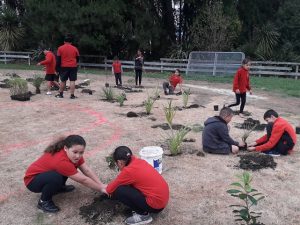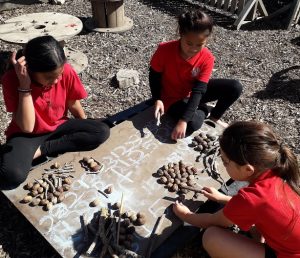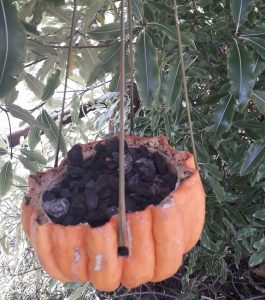
Uncultivated food, e.g., fern roots and shoots, berries. Qualities of wild, natural provision.
Whakatau mai te aio
Whakatau mai te Rangimarie
Whakatau mai te whakaaro pai
Ki runga I te marae o Houngarea,
Ki runga I te marae o Mawhai
Ki runga I te marae o Mihiroa
Ki runga I te marae o Taraia
Arā ko te Pakipakitanga o Hinetemoa
E tū ana te ihi
E tū ana te wēhi
E tū ana te Rangatira
Tūturu whakamaua ki a tina, tina
Haumie, hui e, tiaki e.
Te kura o Pakipaki has been part of the Enviroschool whānau since 2017. Because of the effects of covid-19, the whānau of Te kura of Pakipaki questioned and reflected on their goals and decided to focus more on what it was that they and the whānau were doing for their own taiao and well-being and to have more focus on: Mana ki te atua, Mana ki te wairua, Mana ki te tīpuna and Mana ki te tangata.

Tamariki plant their native rākau.
The kura utilises the Enviroschools resources as well as their own Marautanga/ curriculum, to teach and learn. Te Marautanga o Te Kura o Pakipaki provides the following concepts that are relevant to their local marae; ko Houngarea – He kaitiaki, ko Taraia – he kaimahi, ko Korongotā – he kaiarataki, Ko Mihiroa he kanohi mataara, ko Kahurānaki, he kaitōtuitui which, alongside Enviroschools kaupapa, provides an enriched learning programme for the tamariki.
The kura focussed on the Living Landscapes kaupapa from the Enviroschools Theme Areas resource for a term and the tamariki and whānau were interested in creating a living landscape that provided shelter, kai and rongoā attributes to ngā manu and/or to the whānau.
With this vision born, the networking began. The tamariki worked alongside whānau and Whaea Sonya (Enviroschools Facilitator) to discuss and research the different plant properties that would best provide shelter, kai and rongoa to the manu and to the whānau.

Seeds and sticks gathered locally are used as natural mechanisms for supporting numeracy.
The tamariki researched what types of plants that were used on their marae by their tīpuna. They researched climate, seasons, sun and wind direction to determine the best location for the living landscape. The maramataka was researched and now the kura follow it to know when to grow plants when to reflect, plan, strategise and guide.
Watering systems were researched to ensure that the plants stayed hydrated during the hot summer season. The tamariki looked at mulch and compost and the positive effects of these on the living landscape. Different organisations were contacted to provide their expertise and resources. The support from Recreational Services, Mitre 10 and Tumu timbers was very much appreciated. The Recreational services provided 200 plants, advice, lunch and man power. Mitre 10 provided materials for the furniture that the tamariki designed.
This was the perfect opportunity for the tamariki to share their learning with the whānau. The whānau were invited to plant, to also share their knowledge and to share their experiences during the Whānau Planting Day.

Natural materials are gathered and used to small build structures.

Tamariki create a bird feeder out of pumpkin.

Kamokamo harvest with the kaumatua!

What lives here? Observing bugs on the trees.

The planted area.
Banner image: A karakia clears the way for planting at the awa.